

RFC 2328 - OSPF Version 2. [Docs] [txt|pdf] [draft-ietf-ospf-v...]
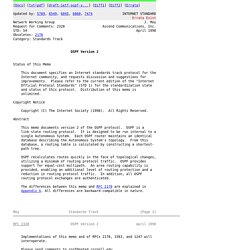
[Diff1] [Diff2] [Errata] Updated by: 5709, 6549, 6845, 6860, 7474 INTERNET STANDARD Errata Exist Network Working Group J. Moy Request for Comments: 2328 Ascend Communications, Inc. STD: 54 April 1998 Obsoletes: 2178 Category: Standards Track Status of this Memo This document specifies an Internet standards track protocol for the Internet community, and requests discussion and suggestions for improvements. Please refer to the current edition of the "Internet Official Protocol Standards" (STD 1) for the standardization state and status of this protocol.
RFC 2328 OSPF Version 2 April 1998 Implementations of this memo and of RFCs 2178, 1583, and 1247 will interoperate. RFC 2328 OSPF Version 2 April 1998 1. This document is a specification of the Open Shortest Path First (OSPF) TCP/IP internet routing protocol. RFC 2328 OSPF Version 2 April 1998 All routers run the exact same algorithm, in parallel. RFC 2328 OSPF Version 2 April 1998 1.2. 2. 3.
Ospf cisco. RFC 2328 - OSPF Version 2. Routing Information Protocol - Wikipedia. The Routing Information Protocol (RIP) is one of the oldest distance-vector routing protocols which employ the hop count as a routing metric.
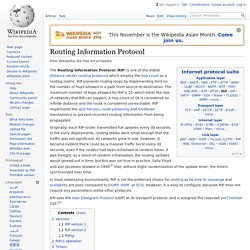
RIP prevents routing loops by implementing limit on the number of hops allowed in a path from source to destination. The maximum number of hops allowed for RIP is 15, which limits the size of networks that RIP can support. A hop count of 16 is considered an infinite distance and the route is considered unreachable. RIP implements the split horizon, route poisoning and holddown mechanisms to prevent incorrect routing information from being propagated. Originally, each RIP router transmitted full updates every 30 seconds. RIP uses the User Datagram Protocol (UDP) as its transport protocol, and is assigned the reserved port number 520.[2] Versions[edit] There are three versions of the Routing Information Protocol: RIPv1, RIPv2, and RIPng. IS-IS - Wikipedia. Intermediate System to Intermediate System (IS-IS) is a routing protocol designed to move information efficiently within a computer network, a group of physically connected computers or similar devices.
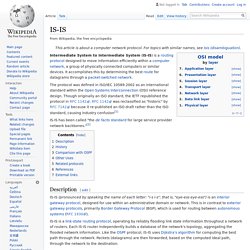
It accomplishes this by determining the best route for datagrams through a packet-switched network. The protocol was defined in ISO/IEC 10589:2002 as an international standard within the Open Systems Interconnection (OSI) reference design. Though originally an ISO standard, the IETF republished the protocol in RFC 1142. RFC 1142 was reclassified as "historic" by RFC 7142 because it re-published an ISO draft rather than the ISO standard, causing industry confusion[1] Open Shortest Path First - Wikipedia. OSPF is perhaps the most widely used interior gateway protocol (IGP) in large enterprise networks.
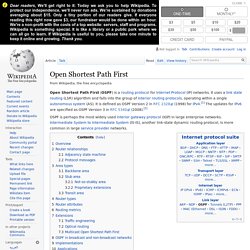
Intermediate System to Intermediate System (IS-IS), another link-state dynamic routing protocol, is more common in large service provider networks. Overview[edit] An OSPF network may be structured, or subdivided, into routing areas to simplify administration and optimize traffic and resource utilization. Areas are identified by 32-bit numbers, expressed either simply in decimal, or often in the same octet-based dot-decimal notation used for IPv4 addresses.
By convention, area 0 (zero), or 0.0.0.0, represents the core or backbone area of an OSPF network. OSPF does not use a transport protocol, such as UDP or TCP, but encapsulates its data directly in IP packets with protocol number 89. OSPF version 3 introduces modifications to the IPv4 implementation of the protocol.[2] Except for virtual links, all neighbor exchanges use IPv6 link-local addressing exclusively. Router relationships[edit] Interior Gateway Protocol. Un article de Wikipédia, l'encyclopédie libre.
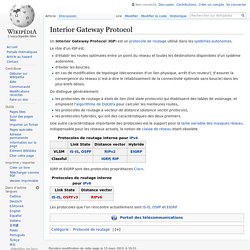
Un Interior Gateway Protocol (IGP) est un protocole de routage utilisé dans les systèmes autonomes. Le rôle d'un IGP est: d'établir les routes optimales entre un point du réseau et toutes les destinations disponibles d'un système autonome,d'éviter les boucles,en cas de modification de topologie (déconnexion d'un lien physique, arrêt d'un routeur), d'assurer la convergence du réseau (c'est-à-dire le rétablissement de la connectivité optimale sans boucle) dans les plus brefs délais.
On distingue généralement: les protocoles de routage à états de lien (link state protocols) qui établissent des tables de voisinage, et emploient l'algorithme de Dijkstra pour calculer les meilleures routes,les protocoles de routage à vecteur de distance (distance vector protocols),les protocoles hybrides, qui ont des caractéristiques des deux premiers. IGRP et EIGRP sont des protocoles propriétaires Cisco. Portail des télécommunications.